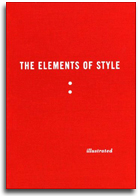Books |
The Elements of Style Illustrated
Strunk & White
By
Published: Jan 01, 2005
Category:
Self Help
This indispensable guide to writing and grammar was first published in 1957. Many millions have read it. A great many of them may have even learned a thing or two from it.
Now it appears — in addition to a paperback edition you can buy on Amazon.com for $6.85 — in a hardcover edition with jaunty illustrations by Maira Kalman that retails for $25 and sells on Amazon.com for $16.47. I say that is a good thing. I say the extra ten bucks makes it a different book: wittier, more fun, lighter. And even if you don’t care for pretty pictures, this new addition refocuses attention on what may be the most useful few pages anyone who has to write — a paper, a letter, a memo, or even real creative writing — will ever encounter.
When E.B. White — yes, the same E.B. White who was one of the greatest stylists ever to write for ‘The New Yorker’ — was a student at Cornell in 1919, William Strunk Jr. was his English professor. Strunk wrote up his thoughts on grammar and published ‘The Elements of Style’ himself. He did not mince words. ‘His book contains rules of grammar phrased as direct orders,’ White notes.
Decades later, with Strunk gone to that place where semi-colons don’t matter, White was asked to revise the book for a wider audience. Now it is impossible to tell where Strunk ends and White begins. That’s not surprising — White is a charter member of the ‘less is more’ school of writing.
The book begins with ‘Elementary Rules of Usage,’ and — because I am of the Strunk & White school — it is a joy to read. ‘In a series of three or more terms with a single conjunction, use a comma after each term except the last, as: red, white, and blue.’ Small point? Yes. But if you do the small things well, the big things follow.
‘Elementary Principles of Composition’ follow. Have a plan, they say. Write in paragraphs. Use the active voice. Omit needless words. Everything every writing teacher says — just in fewer words. (You can’t say these guys set a bad example.)
‘Words and Expressions Commonly Misused’ follows. Those who have read my piece on this subject — Hopefully (Not) — will note the mind-meld. ‘Disinterested’ means ‘impartial’, not ‘uninterested.’ That sort of thing.
My favorite section is ‘An Approach to Style,’ for here the Word Olympians show us what they can do. Style, they tell us, is ‘an increment in writing.’ It is not writing itself. Writing is communicating. Good writing is ‘communication through revelation — it is the Self escaping into the open.’ And if that is done well, it is rewarding work indeed: ‘No writer long remains incognito.’
So ‘approach style warily.’ Avoid devices and tricks. Draw attention to your subject, not yourself. Don’t overstate. Be clear: ‘Muddiness is not merely a disturber of prose, it is also a destroyer of life, of hope: death on the highway caused by a badly worded road sign, heartbreak among lovers caused by a misplaced phrase in a well-intentioned letter, anguish of a traveler expecting to be met at a railroad station and not being met because of a slipshod telegram.’
It occurs to me that is not only good advice for all who must write — it is good advice, period. And the illustrations are amusing. Yeah, I’ll take the hardcover.
To buy the illustrated, hardcover edition of ‘Elements of Style,’ from Amazon.com, click here .
To buy the paperback, non-illustrated edition of ‘Elements of Style’ from Amazon.com, click here.


